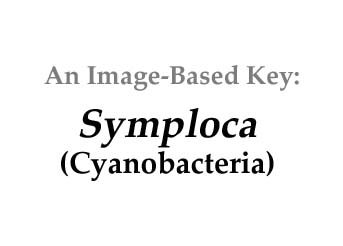|
Home / Cyanobacteria / Filaments / Unbranched / Untapered / No Heterocysts / Visible_sheath / Symploca |
||||
|
|
||||
|
|
||||
|
Click on images for larger format |
||||
Name derivation: |
||||
|
|
||||
Classification: |
||||
|
Symploca Kützing and Gomont, 1892; 32 of 70 species are currently accepted taxonomically (Guiry and Guiry 2013). Order Oscillatoriales; Family Phormidiaceae |
||||
Morphology: |
||||
|
Trichomes initially form a flat mat on a substrate, later grow vertically in ‘fascicles’ (bundles). The vertical fascicles are coiled and parallel forming grass-like mats. Also, fasciles (not trichomes) may become branched or anastomosed (Guiry and Guiry 2013).
|
||||
Similar genera: |
||||
|
|
||||
Anti-tumor agents: |
||||
Several anti-cancer agents have been isolated from strains of Symploca.Symplostatin, a potent antitumor agent, was isolated from Symploca hydnoides VP377 collected at Guam in November 1998. Dolastatin 10, a chemical analogue with one less methyl group and also a potent antitumor agent, was isolated from Symploca sp. VP642 collected at Ulong Channel Palau, April 1999 (Luisch dt al. 2001). Symplostatin 3, an analogue of Dolastatin 10, was isolated from Symploca VP453 was collected at Kaneohe Bay, Oahu, Hawaii USA (Luesch et al. 2002). Malevamide D was isolated from Symploca hydnoides from the south shore of Oahu, Hawaii USA (Horgen et al 2002) More recently Largazole has been isolated from Symploca sp. collected at Key Largo, Florida USA (Taori et al. 2007). Symplocamide A has also been isolated from Symploca sp. collected at Papua New Guinae (Linington et al. 2008). |
||||
Habitat: |
||||
|
Terrestrial (aerophytes) on wet soil, stones or mosses. Some species are marine, epiliths, others grow near thermal springs.
|
||||
References: |
||||
|
Gomont, M. 1892 '1893'. Monographie des Oscillariées (Nostocacées homocystées). Annales des Sciences Naturelles, Botanique, Série 7 16: 91-264, pls 1-7. Guiry, M.D. and G.M. Guiry 2013. AlgaeBase. World-wide electronic publication, National University of Ireland, Galway. http://www.algaebase.org; searched on 04 September 2013. Horgen, D.F., E.B. Kazmierski, H.E. Westenburg, W.Y. Yoshida and P.J. Schuer 2002. Malevamide D: Isolation and structure determination of an Isodolastatin H analogue from the marine cyanobacterium Symploca hydnoides. Journal of Natural Products 65:487-491. Leusch, H., R.E. Moore, V.J. Paul, S.L. Mooberry and T.H. Corbett 2001. Isolation of Dolastatin 10 from the marine cyanobnacteium Symploca species VP642 and total stereochemistry and biological evaluation of its analogue Symplostatin 1. Journal of Natural Products 2001 64:907-910. Leusch, H., W.Y. Yoshida, R.E. Moore, V.J. Paul, S.L. Mooberry and T.H. Corbett 2002. Symplostatin 3, a new Dolastatin 10 analogue from the marine cyanobacterium Symploca sp. VP452. (online) Linington, R.G., D.J. Edwards, C.F. Shuman, K.L. McPhail, T. Matainaho and W.H. Gerwick 2008. Symplocamide A, a potent cytotoxin and chymotrypsin inhibitor from the marine cyanobacterium Symploca. sp. Journal of Natural Products 71:22-27. (online) Taori, K., V.J. Paul and H. Leusch 2007. Structure and activity of Largazole, a potent antiproliferative agent from the Floridian marine cyanobacterium Symploca sp. Journal of the American Chemical Society 130:1806-1807. (online) |
||||



